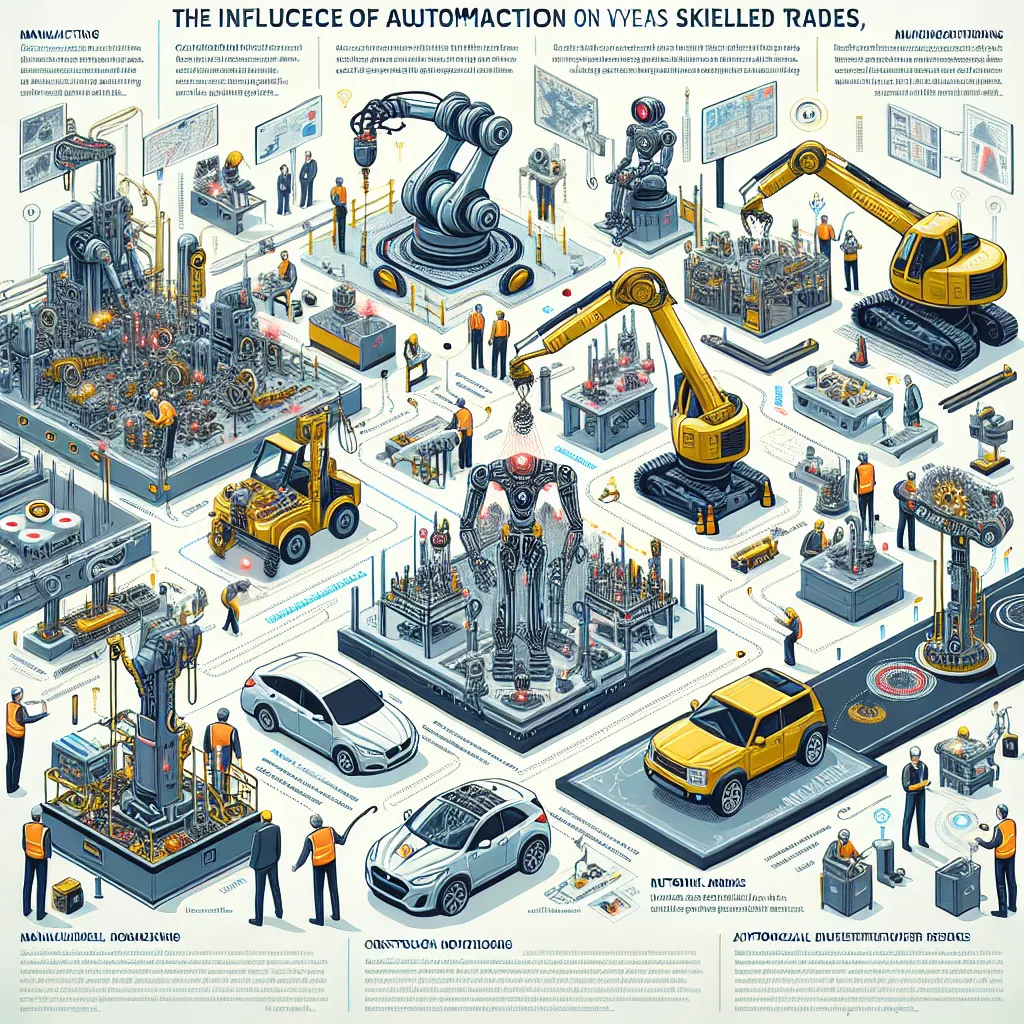In this IELTS Reading practice, we’ll explore the fascinating topic of “Impact of automation on skilled trades.” This subject is increasingly relevant in today’s rapidly evolving job market and is likely to appear in IELTS exams. As an experienced IELTS instructor, I’ve crafted a comprehensive practice test to help you prepare for the Reading section while deepening your understanding of this crucial issue.
 Automation impact on skilled trades
Automation impact on skilled trades
IELTS Reading Practice Test
Passage 1 – Easy Text
The Changing Face of Skilled Trades
Skilled trades have long been the backbone of many industries, from construction to manufacturing. However, the advent of automation is rapidly transforming these sectors. Traditionally, skilled tradespeople relied on their expertise and hands-on experience to perform complex tasks. Now, sophisticated machines and robots are increasingly capable of performing these jobs with precision and efficiency.
One area significantly impacted by automation is the automotive industry. Car assembly lines, once dominated by human workers, now feature robotic arms that can weld, paint, and assemble vehicles with remarkable speed and accuracy. This shift has led to increased productivity and consistency in production, but it has also raised concerns about job displacement.
In the construction industry, automated technologies are making inroads as well. 3D printing of buildings, for instance, is no longer just a concept but a reality in some parts of the world. This technology can create entire structures in a fraction of the time it would take a team of human builders, potentially revolutionizing the way we approach construction projects.
However, it’s important to note that automation isn’t necessarily eliminating all jobs in skilled trades. Instead, it’s often changing the nature of work. Many tradespeople now need to develop new skills to operate, maintain, and program the machines that are becoming integral to their professions. This shift is creating new opportunities for those willing to adapt and learn.
Questions 1-5
Do the following statements agree with the information given in the reading passage?
Write:
- TRUE if the statement agrees with the information
- FALSE if the statement contradicts the information
- NOT GIVEN if there is no information on this
- Skilled trades have always been important in industries like construction and manufacturing.
- Robots in car assembly lines are slower but more precise than human workers.
- 3D printing technology is being used to construct buildings in some countries.
- Automation is completely eliminating all jobs in skilled trades.
- Tradespeople need to acquire new skills to work with automated technologies.
Passage 2 – Medium Text
The Double-Edged Sword of Automation in Skilled Trades
The proliferation of automation in skilled trades presents both challenges and opportunities for workers and industries alike. While the integration of advanced technologies has undoubtedly led to increased efficiency and productivity, it has also sparked debates about job security and the changing nature of work.
One of the most significant impacts of automation is the potential for job displacement. As machines become capable of performing tasks that were once the exclusive domain of skilled workers, there is a legitimate concern about unemployment rates in certain sectors. For instance, in the welding industry, robotic welders can now perform complex welds with a level of precision and speed that surpasses human capabilities. This development has led to a reduction in the demand for traditional welders in some manufacturing settings.
However, it would be myopic to view automation solely as a threat to employment. In many cases, the introduction of automated systems has created new job categories and shifted the focus of human work to more complex, value-added tasks. Take the example of CNC (Computer Numerical Control) machining in the manufacturing industry. While CNC machines have automated many aspects of the machining process, they have also created a demand for skilled operators who can program, maintain, and oversee these sophisticated systems.
Moreover, automation has the potential to enhance workplace safety in many skilled trades. In industries such as mining or hazardous waste management, robots and automated systems can now perform dangerous tasks, reducing the risk of injury or death for human workers. This shift allows skilled tradespeople to focus on safer, more strategic aspects of their work.
The impact of automation also extends to the education and training landscape for skilled trades. Vocational programs and apprenticeships are evolving to include more emphasis on technology and computer skills alongside traditional hands-on training. This hybrid approach aims to produce a new generation of tradespeople who are equally comfortable with digital interfaces and physical tools.
It’s crucial to recognize that the pace and extent of automation’s impact vary significantly across different trades and geographic regions. While some areas may see rapid changes, others might experience a more gradual transition. Factors such as economic conditions, regulatory environments, and cultural attitudes towards technology all play a role in shaping how automation affects skilled trades in different contexts.
Questions 6-10
Complete the summary below.
Choose NO MORE THAN TWO WORDS from the passage for each answer.
Automation in skilled trades has both positive and negative effects. While it may lead to (6) in some sectors, it also creates new job opportunities. For example, in welding, robots can perform tasks with greater (7) and speed than humans. However, in CNC machining, there’s a new demand for workers who can (8) , maintain, and oversee complex machines. Automation also improves (9) in dangerous industries like mining. To adapt, (10) ___ are now incorporating more technology and computer skills into their curricula.
Passage 3 – Hard Text
The Socioeconomic Implications of Automation in Skilled Trades
The pervasive influence of automation on skilled trades extends far beyond the immediate concerns of job displacement and skill adaptation. It is catalyzing a profound transformation in the socioeconomic fabric of communities and nations, necessitating a comprehensive reevaluation of labor policies, education systems, and economic strategies.
One of the most salient consequences of automation in skilled trades is its potential to exacerbate income inequality. As routine and repetitive tasks become increasingly automated, there is a growing bifurcation in the labor market. On one end of the spectrum, there is rising demand for highly skilled workers who can design, implement, and manage automated systems. These individuals often command premium salaries due to their specialized expertise. On the other end, there is a contraction in opportunities for middle-skill workers, particularly those whose roles primarily involve tasks that can be easily automated. This polarization of the job market could lead to a hollowing out of the middle class, a demographic that has traditionally been supported by skilled trade occupations.
The geographic distribution of the impact of automation on skilled trades is not uniform, which could lead to significant regional disparities. Areas with a high concentration of industries susceptible to automation may face economic challenges as traditional jobs disappear faster than new opportunities emerge. This uneven distribution of the benefits and drawbacks of automation could potentially exacerbate existing regional economic inequalities, leading to increased urbanization as workers migrate to areas with more diverse job markets.
Furthermore, the rapid pace of technological change in skilled trades is challenging the traditional models of education and skill acquisition. The half-life of skills – the time it takes for half of learned knowledge to become obsolete – is shrinking, particularly in technology-intensive fields. This phenomenon necessitates a paradigm shift in education, moving from a model of front-loaded learning to one of continuous, lifelong learning. Vocational training institutions and apprenticeship programs must evolve to provide not just initial training but also ongoing skill updates throughout a worker’s career.
The automation of skilled trades also has implications for labor mobility and immigration policies. As the nature of work changes, there may be shifts in the types of skills that are in demand across borders. Countries may need to reassess their immigration policies to attract workers with the right mix of technical and adaptive skills to complement their automated industries. Conversely, countries that are slower to adopt automation in skilled trades may find themselves at a competitive disadvantage in the global market, potentially leading to economic migration of their skilled workforce.
The environmental impact of automation in skilled trades is another factor that warrants consideration. While automation can lead to more efficient use of resources and reduced waste in many industries, it may also accelerate production and consumption patterns that are unsustainable in the long term. Balancing the economic benefits of automation with environmental sustainability will be a critical challenge for policymakers and industry leaders.
In conclusion, the automation of skilled trades is not merely a technological shift but a multifaceted socioeconomic phenomenon with far-reaching implications. It demands a holistic approach that considers not just the immediate effects on employment but also the broader impacts on social structures, economic systems, and environmental sustainability. As we navigate this transition, it will be crucial to develop adaptive strategies that harness the benefits of automation while mitigating its potential negative consequences on individuals and communities.
Questions 11-14
Choose the correct letter, A, B, C, or D.
-
According to the passage, automation in skilled trades is likely to:
A) Increase job opportunities for all skill levels
B) Reduce income inequality
C) Create a divide in the job market
D) Eliminate the need for highly skilled workers -
The impact of automation on skilled trades:
A) Is uniform across all geographic regions
B) May lead to increased urbanization
C) Will definitely solve regional economic inequalities
D) Only affects rural areas -
The concept of “half-life of skills” refers to:
A) The time it takes to learn half of a new skill
B) The period after which half of learned knowledge becomes outdated
C) The halfway point of a worker’s career
D) The time required to automate half of a skilled trade -
The passage suggests that countries slower to adopt automation in skilled trades may:
A) Benefit from a more stable workforce
B) Attract more immigrant workers
C) Experience economic migration of skilled workers
D) Have an advantage in the global market
Questions 15-20
Complete the sentences below.
Choose NO MORE THAN THREE WORDS from the passage for each answer.
-
The automation of skilled trades is causing a ___ in the labor market, with increased demand for highly skilled workers and fewer opportunities for others.
-
The uneven impact of automation across regions could ___ that already exist between different areas.
-
Educational models need to shift from ___ to continuous learning throughout a worker’s career.
-
Countries may need to revise their ___ to attract workers with the right mix of skills for automated industries.
-
While automation can lead to more efficient resource use, it may also accelerate ___ that are not sustainable long-term.
-
Addressing the challenges of automation in skilled trades requires a ___ that considers various socioeconomic factors.
Answer Key
Passage 1
- TRUE
- FALSE
- TRUE
- FALSE
- TRUE
Passage 2
- job displacement
- precision
- program
- workplace safety
- Vocational programs
Passage 3
- C
- B
- B
- C
- bifurcation
- exacerbate existing regional economic inequalities
- front-loaded learning
- immigration policies
- production and consumption patterns
- holistic approach
Conclusion
Understanding the impact of automation on skilled trades is crucial not only for success in the IELTS Reading test but also for grasping the evolving nature of the global job market. This practice test has covered various aspects of this topic, from the immediate effects on specific industries to broader socioeconomic implications.
For further exploration of related topics, you might find these articles helpful:
- How Clean Energy is Driving Job Creation
- The Role of Education in Reducing Income Inequality
- Role of Vocational Training in Job Creation
Remember, success in IELTS Reading comes from regular practice and exposure to a wide range of topics. Keep refining your skills, and you’ll be well-prepared for the exam!


